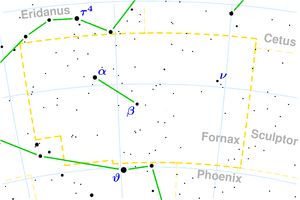 An inconspicuous constellation of the southern sky west of the banks of the celestial river Eridanus. Not observable from northern Europe. Although the constellation is unremarkable when viewed with the naked eye or a binocular, it is not just a small inconspicuous region of the sky marked by a single fourth magnitude star. There are many faint galaxies here, most of which are assigned to Fornax, one of the closest galaxy clusters, 55 million light-years away. It lies in the southern part on the border with Eridania. It contains about 18 galaxies, the brightest of which is NGC 1316. The constellation also contains one member of the Local Group, an irregular dwarf galaxy of extremely low areal brightness known as the Fornax system.
An inconspicuous constellation of the southern sky west of the banks of the celestial river Eridanus. Not observable from northern Europe. Although the constellation is unremarkable when viewed with the naked eye or a binocular, it is not just a small inconspicuous region of the sky marked by a single fourth magnitude star. There are many faint galaxies here, most of which are assigned to Fornax, one of the closest galaxy clusters, 55 million light-years away. It lies in the southern part on the border with Eridania. It contains about 18 galaxies, the brightest of which is NGC 1316. The constellation also contains one member of the Local Group, an irregular dwarf galaxy of extremely low areal brightness known as the Fornax system.
α For - The main yellow star has a brightness of 3.9 mag and is located 40 light-years away from Earth. It is a binary star with an orbital period of 314 years. The yellow companion has a brightness of 7 mag. Around the year 2000, it could be resolved using a smaller telescope with a 6 cm objective diameter when it was at a separation of 5.1". By the year 2020, the separation will increase to 5.8". The system is located 46 light-years away from us.
ω For - A double star distinguishable with a 50mm telescope. The primary white component has a brightness of 4.9mag, the blue companion of 7.7mag is located at a distance of 10.8".
NGC 1316
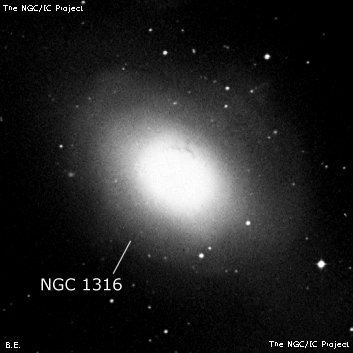
James Dunlop discovered NGC 1316 = D 548 = h2527 on 2 Sep 1826 with his 9" reflector from Parramatta and described "a rather bright, round nebula, about 1.5' diameter, gradually condensed to the centre." He made two observations and his published position was pretty poor -- nearly 20' SE of the galaxy. Dunlop discovered six members of the Fornax cluster, though most (15) were found by John Herschel. Herschel first observed the galaxy on 22 Oct 1835 and noted "vB; pL; lE; vsvmbM, to a nucleus 2" in diameter." On his second sweep he logged "vB; vL; 4' diameter; 1st gradually, then very suddenly very much brighter towards the middle to a stellar ncl"
NGC 1316 is the brightest member of the Fornax cluster and is also known as Fornax A, one of the closest and most famous radio sources in the southern hemisphere. Its radio lobes extend several degrees of sky. Arp classified it as a disturbed galaxy with interior absorption -- like Centaurus A, NGC 1316 contains an extensive system of dust filaments as well as low surface brightness shells and tidal tails, indicating a likely merger. Four supernovae have exploded since 1980.
200/250mm - 8" (9/25/81): bright, round, slightly elongated, small bright core. Forms a pair with NGC 1317 7' N.
400/500mm - 17.5" (11/26/94): very bright, moderately large, oval 3:2 SW-NE, about 2.5'x1.5'. Dominated by an intense 40"x30" core which brightens to a non-stellar nucleus. Forms a pair with NGC 1317 6.3' N. Brightest member of the Fornax I cluster.
Notes by Steve Gottlieb
NGC 1360
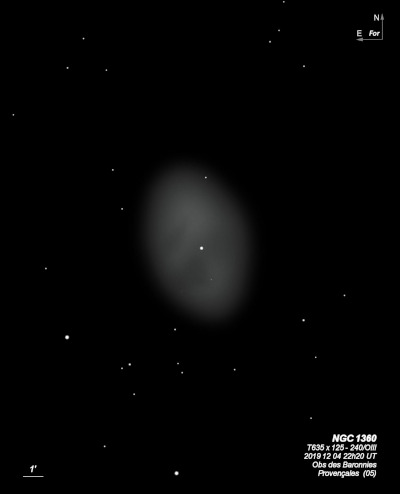
80mm finder (1/1/08): faintly visible at 25x as a dim oval glow surrounding a faint star. Adding an OIII filter significantly increased the contrast and the outline appeared better defined.
Lewis Swift probably discovered NGC 1360 in 1859 with his 4.5-inch comet-seeker (discovery not published until 1885, though). Wilhelm Tempel independently discovered it on 9 Oct 1861, along with NGC 1398, using his personal 4-inch Steinheil refractor from Marseille, but he didn't publish his observation either. Friedrich August Winnecke then found it again in Jan 1868 with his 3.8-inch comet-seeker, estimating a diameter of 10', as well as Eugen Block on 18 Oct 1879 (AN 2293). Dreyer credited Winnecke with the discovery in the GC Supplement (5315). Afterwards, Tempel published his find in 1882, claiming an earlier discovery.
Finally, in the Mar 1885 issue of "The Sidereal Messenger: A Monthly Review of Astronomy" Swift reported that "in 1859 while searching in Eridanus for comets I ran upon the most conspicuous nebulous star visible from this latitude - a 7th magnitude star nearly in the center of a bright nebulosity. As both were so bright, I, of course, supposed they were well known. Not until five years since was I aware that this wonderful object was not in the G.C." Dreyer credited Swift (his earliest discovery) and Winnecke in the NGC. So, NGC 1360 was independently "discovered" by four observers, the most (along with NGC 6364 and 7422) for any NGC number, according to Wolfgang Steinicke. Robert Innes found it again on 8 Dec 1909 and reported it as "easily seen in the 2-inch finder as in the 9-inch" (Union Observatory, Johannesburg). He noted it was oval nebula with the longer axis SW-NE, but apparently wasn't realize of the previous discoveries.
This is one the brightest objects missed by the Herschels as well as by John Dunlop. In 1914, Hardcastle classified NGC 1360 as a spindle-shaped nebula. The following year, Knox-Shaw at the Helwan Observatory reported it wasn't a spindle but was "probably like the Owl", based on a photograph taken with the Reynolds reflector. Minkowski first classified it as definitely a planetary in 1946. A star was incorrectly plotted at the position on the Uranometria 2000 Atlas (first edition) because the CoD and CPD catalogue (used as a source for the U2000) included the central star.
300/350mm - 13.1" (10/10/86): very large, oval 4:3, very bright mag 10-11 central star. Impressive at 88x using an OIII filter.
13.1" (10/20/84): large, pale oval ~N-S, bright central star. Appears moderately bright using a filter.
400/500mm - 17.5" (11/17/01): At 100x with OIII filter, this huge planetary appears a very large oval 3:2 or 4:3 SSW-NNE, ~6'x4.5' with a striking central star. Appears clearly brighter on the north side of the central star in a section defined by a triangular wedge with apex at the central star. The nebulosity dims a bit on the west side as well as the south.
17.5" (10/8/88): very bright, elongated 3:2 SSW-NNE, 6'x4' diameter, very bright mag 11 central star, almost even surface brightness. Very impressive planetary with or without OIII filter.
Notes by Steve Gottlieb
NGC 1097
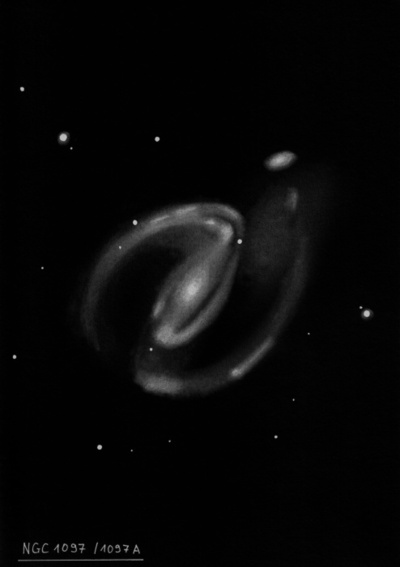
William Herschel discovered NGC 1097 = H V-48 =h2495 on 9 Oct 1790 (sweep 972) and logged "vB; E 75? np to sf; about 8' long. A very bright nucleus confined to a small part about 1' diameter." John Herschel recorded this barred spiral on 18 Nov 1835 from the Cape as "B, L, vmE, pspmbM, 3' long; pos = 151.1?." The next night he logged "B, L, vmE, psvmbM to a pL, R nucleus; 4' long, 40" broad."
Dunlop's D 625 possibly refers to NGC 1097, although his position is too rough to make a positive identification. He found a "round nebula, about 2' dia, very bright at the centre, and very faint from the centre to the margin , almost equally faint from the bright nucleus to the margin. There are two pretty bright small stars following the nebula rather north."
200/250mm - 8" (10/13/81): bright, elongated NW-SE, bright core.
400/500mm - 17.5" (10/17/87): very bright, very large, very elongated NW-SE, very bright core. A companion galaxy NGC 1097A is attached at the NW end.
600/800mm - 30" (10/13/15 - OzSky): NGC 1097 was one of the top highlights of my October 2015 trip to Australia. At 303x; this showpiece barred spiral contains a bright central bar ~4.5'x1.5' NW-SE. The bar is sharply concentrated with an extremely bright, slightly elongated NW-SE core but no distinct stellar nucleus.
A prominent spiral arm is attached on the northwest end of the bar. The arm is relatively thin, well defined and knotty as it curls counterclockwise to the east, dimming out gradually about 3' ENE of center. A large bright knot is close to the northwest end of the bar, just inside the beginning of the arm and close east of a superimposed mag 14.5 star. NED catalogues this region with the multiple designations NGC 1097:[EKS96] 148 and [EKS96] 151 from the 1996 "An Atlas of H II Regions in Nearby Seyfert Galaxies" in ApJS, 105, 93. Roughly halfway along its length is a pair of fairly prominent HII knots. The first is [EKS96] 245, a 12" knot 2.5' NNE of center. Close east is slightly larger [EKS96] 300/304, 2.5' NE of center. The arm then fades as it passes just south of a mag 15 star.
At the southeast end of the bar a delicate, thin spiral arm unfurls counterclockwise towards the northwest. About halfway along its length is a slightly brighter elongated patch extending ~30" in length, with designations [EKS96] 100/105/119 and others. The arm dims out about 3' WSW of center. The arms stretch about 6' tip to tip, giving overall dimensions of perhaps 7'x6'.
The satellite galaxy NGC 1097A is superimposed in the halo on the northwest side, 3.3' from center. It appeared moderately bright, fairly small, elongated 2:1 WNW-ESE, 40"x20".
Notes by Steve Gottlieb
NGC 1365
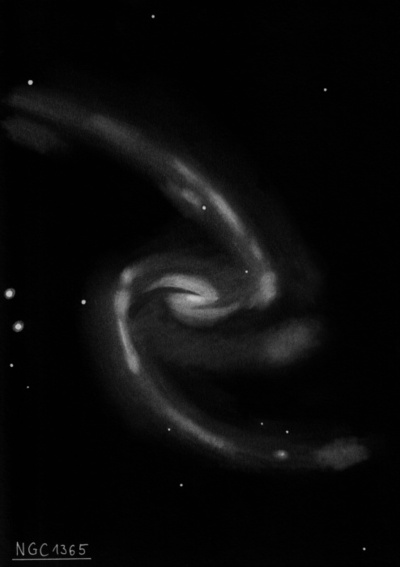
James Dunlop discovered NGC 1365 = D 562 = h2552 on 2 Sep 1826 with his 9" reflector from Parramatta and described "a pretty large faint round nebula, about 3 1/2' diameter, gradual slight condensation to the centre, very faint at the margin." He made two observations though his published position is off by 10 tmin in RA. By examining Dunlop's original papers, Glen Cozens found a copying error and Dunlop's handwritten position falls ~8' E of NGC 1365.
John Herschel independently discovered NGC 1365 on 28 Nov 1837 and described "A very remarkable nebula. A decided link between the nebula M 51 and M 27. Centre very bright; somewhat extended; gradually very much brighter to the middle; a 13th magnitude star near the edge of the halo involved. The area of the halo very faint; general position of the longer axis 20.8 degrees. whole breadth = 3'. See Pl. IV. fig. 1." The next night he made a second observation and logged "very bright, extended, resolvable nucleus; or has 2 or 3 stars involved; the preceding Arc is the brighter. I think the oval is in some degree filled up to the south." Based on his size estimate, JH may have only observed the central region. The NGC attributes JH with the discovery.
Joseph Turner observed and sketched a pair of dramatic spiral arms, central bar and core as a "Z" shaped figure using the 48-inch Great Melbourne Telescope on 2 Dec 1875 (unpublished lithograph plate II, figure 10), as well as Albert Le Sueur on 30 Jan 1870 (plate VII, figure 84).
200/250mm - 8" (1/1/84): fairly bright, fairly large, bright core, diffuse halo, broad concentration.
8" (9/25/81): moderately large, elongated, gradually brighter core.
300/350mm - 13.1" (12/22/84): bright, elongated core, large, 3' diameter, very diffuse outer halo. Member of the Fornax I cluster.
400/500mm - 18" (12/30/08): although a pale imitation of the view from Australia, with careful viewing at 175x the spiral arm attached at the west end of the central bar was faintly visible sweeping to the NNE for ~3' in length. The counterpart on the SE side was not seen.
600/800mm - 24" (11/18/12 - Magellan Observatory, Australia): viewed SN2012fr, a type Ia supernova, as a mag 12 star situated just 2" west and 52" north of the center of NGC 1365.
24" (4/5/08 - Magellan Observatory, Australia): this is the best visual barred spiral in the sky and although it was only at 33? elevation (well past the meridian), the view was stunning at 200x with its long sweeping arms making a slashing cosmic "Z" in the eyepiece. I was also surprised by the structure in the fairly small, extremely bright core that is embedded in the 3' E-W bar. On the north edge of the mottled core, a very short, hooking appendage extended towards the northeast with a fainter counterpart on the southwest end. This gave the small core the appearance of a tiny barred spiral! At the west end of the bar a bright arm emerges, dramatically sweeping back to the NNE (sharp 110? angle) beyond a mag 13 star that is situated near the 1/3 mark of its total length. The counterpart on the east end of the bar shoots to the southwest, reaching a faint star at its end. The total distance between the tips of the arms is roughly 10'.
900/1200mm - 48" (10/22/11): stunning view of this huge, barred spiral with the full extent of the long, graceful arms clearly visible and a great deal of structure. The very bright bar runs nearly 3' WSW-ENE and contains an extremely bright core that increases to a striking knotty nucleus that is sliced by a dust lane running SW to NE. The dust lane creates a mini spiral in the center with a bright elongated section south of the lane that has an "arm" attached at its northeast end that curls to the southwest. The section of the nucleus north of the lane appears as a small but brighter arm, gently curving from SW to NE.
The main northern spiral arm is attached at the west end of the bar and has a bright, mottled "knot" as it emerges from the bar and heads north-northeast. This knot contains the HII regions #23-25 from Paul Hodge's 1969 "HII Regions in Twenty Nearby Galaxies" (ApJS, 18, 73). It was also the site of SN 2001du, a supernova discovered visually by Robert Evans. This arm dims a bit and then brightens along a 1' strip (containing #19) just northwest of a superimposed mag 13.5 star. The arm then dims significantly but can be easily traced a total length of 6.5', ending just southeast of a mag 13.5-14 star.
The main southern arm emerges on the east-northeast end of the bar as a brighter patch or OB association that contains #2-3, matching the west end. A group of stars is just beyond this patch to the east. The arm extends ~6.5' SW and is bordered by several stars; a mag 14.5 star is on the south edge before the middle of the arm, a mag 16 star 1.3' due south of this star and two mag 15/16 stars are on the inside (northern edge) beyond the middle of the arm. A very small, very faint knot is near the southwest tip of the arm. The arm dims significantly at this point but bends and continues another 2' NW.
Notes by Steve Gottlieb
NGC 1399
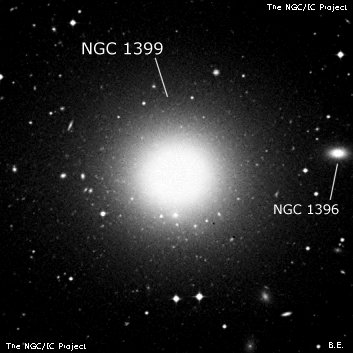
John Herschel discovered NGC 1399 = h2569 on 22 Oct 1835 and recorded a "globular cluster, vB, pL, psbM, resolvable or resolved, 2'." He also described a few other galaxies in the Fornax cluster as globulars (NGCs 1310, 1379, 1387 and 1436). In 1915, Harold Knox-Shaw reported it was not resolved visually awith the 30-inch Reynolds reflector at the Helwan Observatory.
200/250mm - 8" (10/13/81): fairly bright, round, bright core.
300/350mm - 13.1" (12/22/84): bright, large faint halo is broadly concentrated, brighter core. A star is superimposed 0.3' N of the center. This galaxy is the second brightest and second largest in the core of the Fornax I cluster. NGC 1404 is 10' SE.
400/500mm - 18" (12/17/11): very bright, large, round, 3' diameter. The outer halo has a fairly low surface brightness but the central portion is sharply concentrated with a very bright 35" core. The core continues to brighten significantly to a quasi-stellar nucleus. A star is superimposed less than 20" NNE of center. Brighter of a pair with NGC 1404 10' SSE.
Notes by Steve Gottlieb
NGC 1398
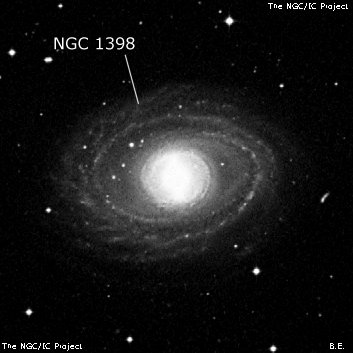
Wilhelm Tempel discovered NGC 1398, along with an independent discovery of NGC 1360, on 9 Oct 1861 using his personal 4" Steinheil refractor from Marseille. Tempel didn't announce the discovery until May 1882 and in the meantime it was independently found by Friedrich August Winnecke on 17 Dec 1868 with a 4.5" refractor at Karlsruhe and Eugen Block (AN 2287) on 18 Oct 1879 with a 4" refractor at Odessa. This is the brightest galaxy discovered by Tempel (V = 9.7) and the most southerly.
Based on plates taken at the Helwan observatory in 1927-31, NGC 1398 was described as an "oval ring 5' diameter, surrounding a faint, disc 1.5' diameter with a vB central almost stellar ncl, 1/2' with a pF axis E 10?."
200/250mm - 8" (10/13/81): fairly bright, moderately large, round, bright core.
400/500mm - 17.5" (11/26/94): very bright, moderately large, elongated 2:1 N-S, 2.2'x1.1', well concentrated with a very bright 30" rounder core and a stellar nucleus. NGC 1360 lies 1.3? NW. This galaxy has a beautifuil inner and outer ring structure on deep images.
Notes by Steve Gottlieb
NGC 1380
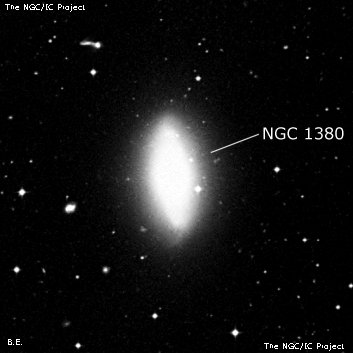
James Dunlop discovered NGC 1380 = D 574 = h2559 on 2 Sep 1826 with his 9" reflector at Parramatta. He recorded "a rather faint pretty well-defined elliptical nebula, about 1' long, and 50" broad, a little brighter to the centre." His position was well off, 19.5' ESE of ESO 358-028 = PGC 13318. John Herschel made a single observation on sweep 635 (19 Oct 1835) and logged, "very bright; large; round; pretty suddenly brighter towards the middle; A fine nebula." He added: "The obs. of the place like that of Dunlop 591 above was lost by setting the instrument on the place given in Mr Dunlop's Catalogue, and relying on his RA (3h 31m) which is too great, instead of sweeping over them, when they could not have escaped being regularly taken." In 1865 Julius Schmidt measured a more accurate position with the 6.2" refractor at the Athens Observatory.
200/250mm - 8" (10/13/81): fairly bright, moderately large, elongated, bright core.
300/350mm - 13.1" (12/22/84): very bright, elongated 2:1 N-S, bright core, faint elongated halo. A very faint mag 14 star is SW of the core 1.2' from the center. Member of Fornax I cluster.
400/500mm - 18" (12/17/11): extremely bright, large, elongated ~5:3 N-S, ~3.0'x1.8'. Sharply concentrated with an intense, elongated core that brightens to the center, though there was no evident nucleus. A mag 13.5 star is superimposed ~0.9' SW of center. This is one of the brightest Fornax cluster galaxies.
Notes by Steve Gottlieb
NGC 1404
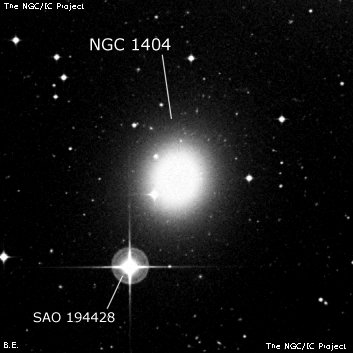
John Herschel discovered NGC 1404 = h2571 on 28 Nov 1837 and recorded (the following night) "vB, R, psmbM, 40", has a star N.f." His RA was 12 seconds too large and the star is south following but this identification is certain. In 1865 Julius Schmidt measured a more accurate position with the 6.2" refractor at the Athens Observatory, though he initially reported it as a new nebula. His later table in 1876 correctly identifies it as h2571.
200/250mm - 8" (10/13/81): fairly bright, small, round, bright core. A mag 8 star is close SSE.
300/350mm - 13.1" (12/22/84): bright, fairly small, round, bright core. Located just 2.8' NNW of mag 8.1 SAO 194428. NGC 1399 lies 10' NW. Member of Fornax I cluster.
400/500mm - 18" (12/17/11): very bright, moderately large, round, 1.5' diameter. The outer halo gradually increases then brightens fairly rapidly to a small, very bright core. The core increases to the center but a stellar nucleus wasn't seen. A mag 12-12.5 star is 45" SE, at the edge of the halo. Mag 8.1 HD 22862 lies 2.8' SE. NGC 1404 is smaller but has an overall higher surface brightness than NGC 1399, located 10' NNW. NGC 1396 lies 4.6' W.
At 285x, supernova 2011iv, discovered on Dec 2, was easily visible just 7" W and 8" N of center. The supernova was similar in brightness to the mag 12-12.5 star at or just off the southeast edge of the halo.
Notes by Steve Gottlieb
NGC 1425
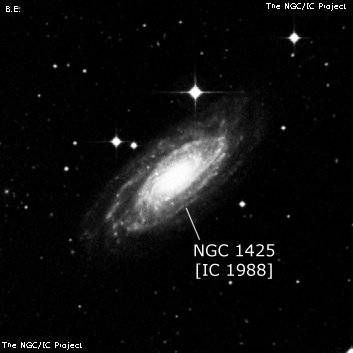
William Herschel discovered NGC 1425 = H II-852 on 9 Oct 1790 (sweep 972) and recorded "F, pL, irr R, gbM." His position is accurate. Harold Corwin comments that Lewis Swift's object Sw. XI-61 (later IC 1988), found on 3 Oct 1897 (date given as 14 Oct in his large 11th list in AN) and described as "eF, pL, R; 2 sts near f, wide D* np", may be a duplicate observation. There are two stars "near following" this galaxy, but the wide double star is west-southwest, not northwest per Swift. The identification NGC 1425 = IC 1988 also requires that Swift made a 10? error in declination, though these types of errors are not uncommon in Swift's later observations from southern California.
300/350mm - 13.1" (10/10/86): fairly bright, moderately large, elongated 2:1 NW-SE, bright core. A pair of mag 12.5/14 stars at 30" separation are 2' NE of center and a mag 11 star lies 2.5' N.
Notes by Steve Gottlieb
NGC 1201
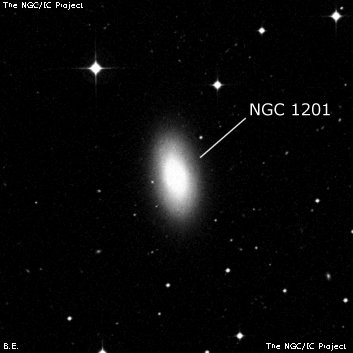
William Herschel discovered NGC 1201 = H I-109 = h283 on 26 Oct 1785 (sweep 466) and logged "cB; mbM; iR; resolvable." On a later sweep he wrote, "cB, pS, lE in the direction of the meridian, mbM, resolvable, 1.5' long." Finally on sweep (593) he recorded "pB, pS, bM, lE." On 14 Oct 1830 (sweep 306), John Herwschel remarked "B; R; psbM; 30" [diameter]." His position was just off the north end of the galaxy.
200/250mm - 8" (10/13/81): fairly bright, small, slightly elongated N-S, small bright core. A mag 11 star is 4' NE.
400/500mm - 17.5" (11/26/94): fairly bright, moderately large, elongated 2:1 N-S, 1.6'x0.8', well concentrated. Dominated by a bright, very small round core and an almost stellar nucleus. Forms the southern vertex of an acute triangle with a mag 12 star off the NNW side 2.9' from center and a mag 10.5 star 3.8' NE of center.
Notes by Steve Gottlieb
NGC 1371
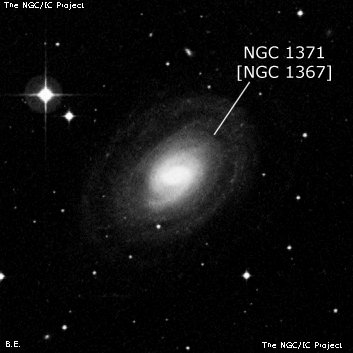
William Herschel discovered NGC 1371 = H II-262 = h2555 on 17 Nov 1784 (sweep 321) and logged "F, a little & irr E above 1' in dia." His position is ~5' north of ESO 482-010 = PGC 13255. JH called the galaxy "B, L, R, psbM, 2'." and noted a 4' error in the PD in his working list from Caroline Herschel.
Ormond Stone independently found the galaxy in 1886 and recorded LM 1-106 as "mag 13.0 [bright], *9, nf 5.0'." His rough position is a good match with H II-262 = NGC 1371 and his comment about the nearby star clinches the equivalence. Dorothy Carlson and Harold Corwin both conclude NGC 1371 = NGC 1367, with NGC 1371 the primary designation.
200/250mm - 8" (10/13/81): faint, moderately large, bright core, diffuse halo.
400/500mm - 17.5" (11/26/94): fairly bright, moderately bright, elongated 3:2 NW-SE, 2.5'x1.5', halo fades into the background. Very bright elongated core 30" diameter increases to a stellar nucleus. A mag 8.3 star SAO 168653 (wide double at 53" with a mag 11.5 star) is 4.5' NE. NGC 1360 lies one degree SSW.
Notes by Steve Gottlieb
NGC 1387
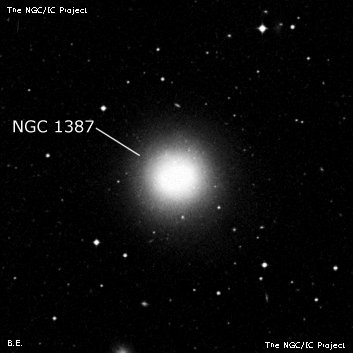
John Herschel discovered NGC 1387 = h2564 on 25 Dec 1835 and described a "globular cluster, vB, R, gmbM, 90 arcseconds, A globular cluster in all probability identical with this, was also seen in Sweep 636, while searching beyond the meridian for Dunlop 562." His position is accurate. He also described a few other galaxies in the Fornax cluster as globulars (NGCs 1310, 1379, 1399 and 1436). In 1915 Knox-Shaw reported it was similar to 1380 and 1399 "and probably a nebula", based on a photograph as well as a visual observation with the 30-inch Reynolds reflector at the Helwan Observatory.
200/250mm - 8" (10/13/81): faint, small, round, broad concentration.
300/350mm - 13.1" (12/22/84): moderately bright, small, round, possible faint stellar nucleus. Member of Fornax I cluster. NGC 1381 lies 14' NNW and NGC 1379 11.5' WNW.
400/500mm - 18" (12/17/11): at 285x appeared bright to very bright, fairly large, round, 2' diameter. Sharply concentrated with a very bright 25"-30" core that increases to a stellar or quasi-stellar nucleus. Bracketed at low power by NGC 1379 11.5' WNW and NGC 1399 19' ENE.
Notes by Steve Gottlieb
NGC 1385
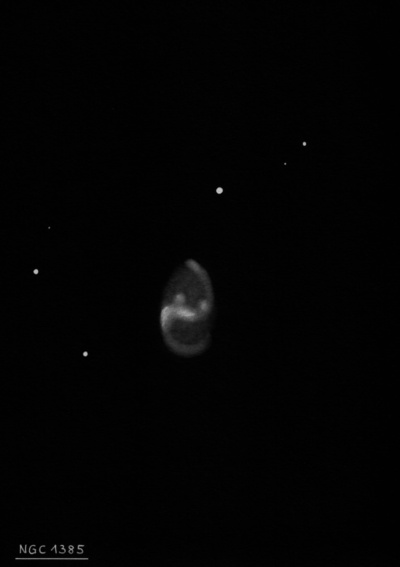
William Herschel discovered NGC 1385 = H II-263 = h2563 on 17 Nov 1784 (sweep 321) and recorded "F but less bright than the last [NGC 1371], bM, about 1.5' dia." His position is 4' too far north-northwest. John Herschel called this object "B, R, gpmbM, 40 arcsec" and measured an accurate position.
200/250mm - 8" (10/13/81): faint, fairly small, brighter core.
400/500mm - 17.5" (11/26/94): fairly bright, moderately large. Dimensions are 2.5'x2.0' slightly elongated N-S, but with an irregular appearance. A bright bar appears to extend through the galaxy WNW-ESE surrounded by an irregular patchy halo more elongated N-S. Spiral structure is strongly suggested with a spiral arm on the NE side. The galaxy appears more extensive north of the bar. Located within a 10' string of four mag 11-12 stars oriented SW-NE.
900/1200mm - 48" (10/29/19): at 610x; very bright, large, excellent spiral with an unusual, chaotic appearance! Overall, the galaxy is elongated ~5:3 N-S, ~3.0'x1.8', with a prominent thick bar running ~E-W through the center. A small, bright knot is close north of the west end of the bar.
A brighter, elongated patch (probably a short section of a spiral arm) was easily seen extending north of the bar. Only the initial part of the southern arm attached to the west end of the bar was visible. The main, long spiral arm was rooted on the east end of the bar and stretched well north of the central region. Its surface brightness seemed irregular or patchy. The arm faded and was less defined as it curled clockwise and spread west on the north end of the halo. The south portion of the halo was faint overall (due to dust) but displayed a semi-circular outline due to the very low surface brightness southern arm.
LEDA 788671 was picked up 3.5' S of NGC 1385. This small galaxy was faint (B = 16.4) and ~12" in diameter.
Notes by Steve Gottlieb
NGC 1079
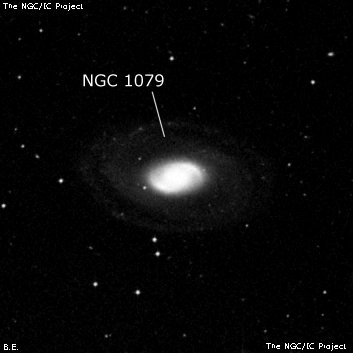
John Herschel discovered NGC 1079 = h2494 on 14 Nov 1835 and logged "B, pmE, sbM, 90" long, 40" broad". His position is accurate.
300/350mm - 13.1" (10/10/86): moderately bright, fairly large, elongated 2:1 E-W, bright core, faint stellar nucleus, faint elongated halo.
Notes by Steve Gottlieb
NGC 1406
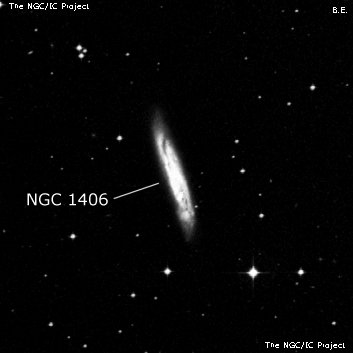
John Herschel discovered NGC 1406 = h2572 on 18 Nov 1835 and accurately recorded "F, vmE, vglbM, 2' l, 20" br; *7 mag precedes in parallel."
300/350mm - 13.1" (1/18/85): fairly faint, edge-on 5:1 SSW-NNE, moderately large, 3.0'x0.6, brighter core, dims at ends of extensions. Located 16' ESE of mag 7.4 SAO 194416.
Notes by Steve Gottlieb
NGC 1350
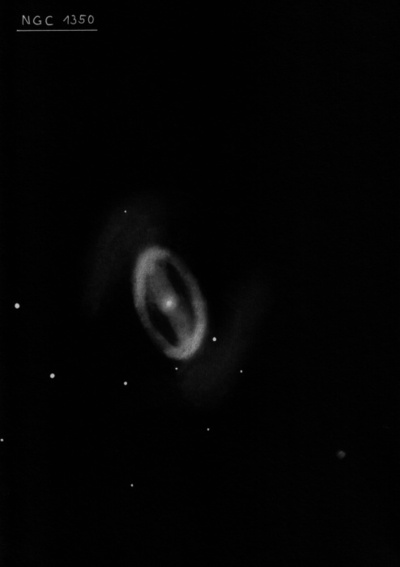
James Dunlop discovered NGC 1350 = D 591 = h2545 on 24 Nov 1826 with his 9" reflector from Parramatta, NSW and noted (single observation) "a very faint small ill-defined nebula." His position is 11' SE of ESO 358-013 = PGC 13059. John Herschel observed the galaxy in his sweep of 19 Oct 1835, logging "bright, large, much elongated, but with a round nucleus much brighter than the environing faint atmosphere. PD roughly taken. Transit missed, the observation having been lost by relying on the RA given by Mr. Dunlop's Catalog (3h 25m) which is too great. That here set down is assumed at random as probably nearer the truth." His approximate position was corrected by DeLisle Stewart in NGC Corrections, Harvard College Observatory and repeated in the IC 2 Notes.
Harold Knox-Shaw photographed the galaxy at the Helwan Observatory between 1909-11 with the 30" reflector and described an "oval ring with central star and traces of structure external to this in the form of either another ring or spiral arms".
200/250mm - 8" (10/13/81): fairly bright, moderately large, elongated 2:1 N-S, bright core.
400/500mm - 17.5" (11/26/94): bright, fairly large, elongated 3:2 N-S. The halo appears about 3'x2' although difficult determine the exact dimensions as the halo fades gradually into the background. Sharply concentrated with a very bright 20" round core and stellar nucleus. A very faint star is just west of the south extension and two mag 12 stars are 2.7' SE and 3.0' E of center. Located 6' SW of mag 7.2 SAO 194353. Fornax I cluster member.
Notes by Steve Gottlieb
NGC 1326
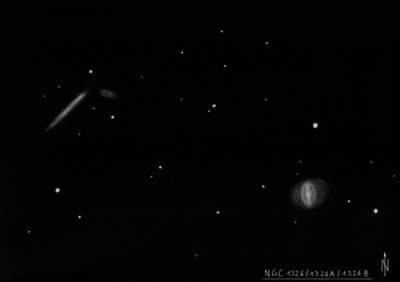
John Herschel discovered NGC 1326 = h2535 on 29 Nov 1837, recording it as "60" diameter, vsvmbM to a nucleus, ? a disc." His position is accurate (on the SE side of the halo).
200/250mm - 8" (10/13/81): faint, fairly small, round, bright core.
400/500mm - 17.5" (11/26/94): bright, fairly small, round, 1.3' diameter, well concentrated with a small bright core and bright stellar nucleus. On a line with three mag 13 stars 2.7' and 4.2' WSW and 3.6' to the ENE. A brighter mag 11 star lies 4.3' NNW. Located on the SW side of the Fornax I cluster.
Notes by Steve Gottlieb
NGC 986
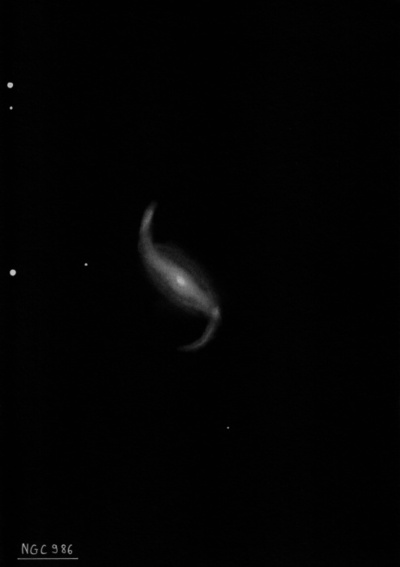
James Dunlop discovered NGC 986 = D 519 = h2487 on 5 Aug 1826 with his 9" reflector at Parramatta (near Sydney) and described "a faint nebula, of an irregular round figure, about 30" diameter, north of a bright small star." His position is 9' SE of NGC 986 (typical error) and there are no other nearby brighter galaxies that he might have been picked up instead.
John Herschel described the galaxy on 23 Oct 1835 as "pB, L, psbM, 3' long 2' broad, either binuclear or more elongated on the n.f. side than on the opposite." On a later sweep he logged "B, L, pmE, very suddenly much brighter middle, 100" long 60" broad, unequally bright, and exhibiting an approach to binuclear form." See Plate VI, figure 14 of the CGH Observations. Herschel's secondary nucleus appears to be the brighter southwest end of the central bar.
Joseph Turner sketched the galaxy on 29 Nov 1875 with the 48" Great Melbourne Telescope. He resolved it as a stretched S-shaped barred spiral. See Plate I, figure 8 "Observations of Southern Nebulae made with the Great Melbourne Telescope 1869 - 1885". Albert Le Sueur earlier made a sketch (plate VII, figure 80) that was not published.
200/250mm - 8" (1/1/84): fairly faint, fairly small, elongated SW-NE, bright core, diffuse edges.
400/500mm - 17.5" (12/28/94): fairly bright, moderately large, elongated 2:1 WSW-ENE, 2.5'x1.2'. Dominated by a 20" rounder core. A nice evenly matched mag 10.5 pair at 12" separation is 9' NNE with another similar star 1' S. Located 8' due north of mag 9 SAO 193771.
600/800mm - 30" (11/4/10 - Coonabarabran): at 264x, this beautiful, barred S-shaped spiral appeared very bright, large, with a very bright elongated central region that increased to a small, very bright core and bright stellar nucleus. Within the central region it was brighter along the central axis (bar) oriented SW to NE. At the southwest end of the central bar a relatively thin arm emerged and swept ~1.3' SE (clockwise). From the NE end of the central region another thin arm shot north for 1.5' and contained a very small, brighter knot or HII region.
Notes by Steve Gottlieb
IC 1993
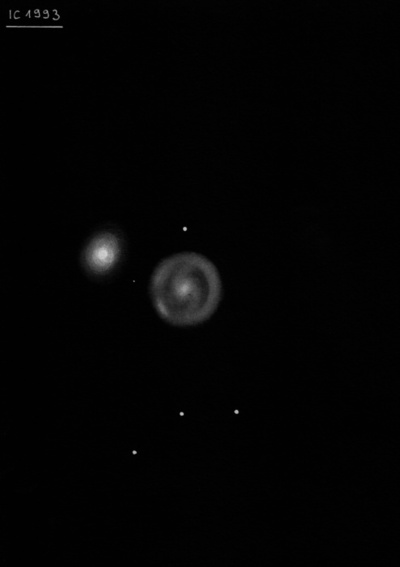
Lewis Swift discovered IC 1993 = Sw. XI-62 on 19 Nov 1897 and logged "eF; L; cE; 7 1/2m in contact; ee diff." In his Astronoical Journal list (15th object is the 5th discovery list from Lowe Observatory), Swift mentions the star "nearly obliterates it" and has a note "it seems strange, although in close contact if not partly superimposed on the star, that it was not found long ago. I think it would, could it be detached from the star, be quite an interesting one.
400/500mm - 18" (1/21/04): fairly faint, fairly large, low surface brightness glow with just a very weak concentration, slightly elongated ~N-S, roughly 2.0'x1.7'. Located just 1.5' ESE of mag 9.3 SAO 194528! Outlying member of the Fornax I cluster on the northeast side.
Notes by Steve Gottlieb
NGC 922
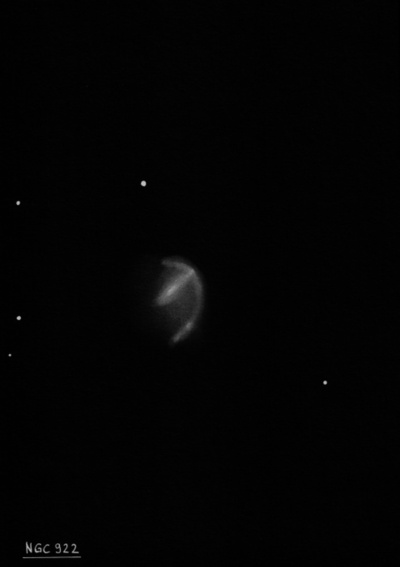
William Herschel discovered NGC 922 = H III-239 = h2478 on 17 Nov 1784 (sweep 321) and logged "vF, S, near 1' diameter or more". John Herschel reported on on 20 Nov 1835 (sweep 646), "pB; R; gpmbM; 60" [diameter]".
200/250mm - 8" (1/1/84): fairly faint, even surface brightness, slightly elongated N-S. A mag 12.5 star is 2' NNW.
400/500mm - 17.5" (12/4/93): moderately bright, slightly elongated N-S, 1.2'x1.0', weak concentration, stellar nucleus with direct vision. A mag 12 star is 2' NNW.
Notes by Steve Gottlieb